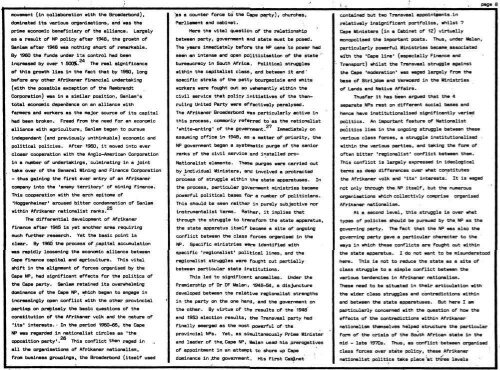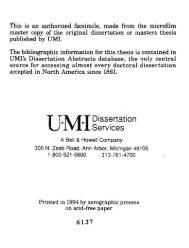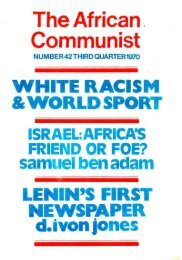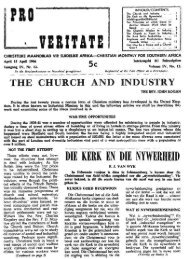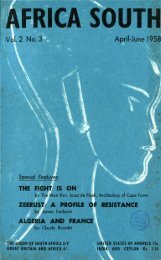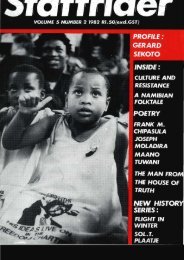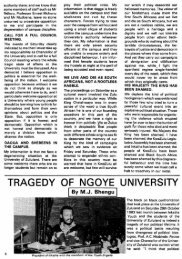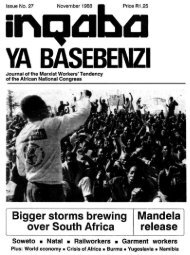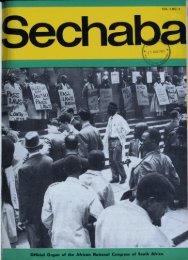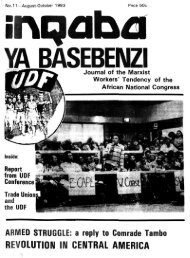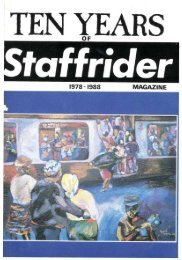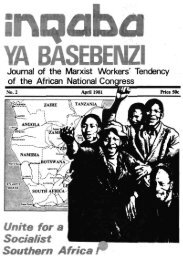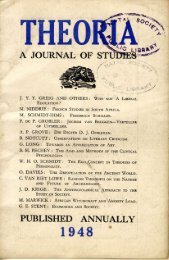Create successful ePaper yourself
Turn your PDF publications into a flip-book with our unique Google optimized e-Paper software.
movement (In collaboration with the Broederbond),<br />
dominated its various organisations, and was the<br />
prime economic beneficiary of the alliance. Largely<br />
as a result of HP policy after 1946, the growth of<br />
Senlem aftar 1946 wee nothing short of remarkable.<br />
By i960 the funds uodar its control had been<br />
increased by over 1 500)1. The real eignificance<br />
of thie growth lies in the fact that by 1960, long<br />
before any other Afrikaner financial undertaking<br />
(with the possible exception of the Rembrandt<br />
Corporation) eas in a similar position, Senlem's<br />
total aconoailc dependence on an alliance elth<br />
farmers and workers as the eejor source of its capital<br />
had been broken. Freed from the need for an economic<br />
alliance elth agriculture. Senlaa began to pursue<br />
Independent (and previously unthinkable) economic and<br />
political policies. After 1960, it moved into ever<br />
closer cooperation eith the Anglo-American Corporation<br />
in a number of undertakings, culminating in a Joint<br />
take over of the General etining and Finance Corporation<br />
- thua gaining the first ever entry of an Afrikaner<br />
company into the 'mammy territory' of mining finance.<br />
This cooperation eith the arch epltoee of<br />
'Hoggenheimer' aroused bitter condemnation of Sanlam<br />
within Afrikaner nationalist ranks. ZS<br />
The differentiel development of Afrikaner<br />
finance after 1905 la yet another area requiring<br />
much further research. Yet the basic point is<br />
clear. By 1960 the process of capital accumulation<br />
was rapidly loosening the economic alliance between<br />
Cepe finence capital and agriculture. This vital<br />
shift in the alignment of forces organised by the<br />
Cape NP, had algnificant effects for the politics of<br />
the Cape party. Sanlem retained its overwhelming<br />
dominance of the Cepe nP, which began to engage in<br />
increasingly open conflict with the other provincial<br />
parties on precisely the basic questions of the<br />
constitution of the Afrikaner volk and the nature of<br />
ff ita B interests. * In the period 1960-66, the Cepe<br />
NP eas regarded in nationalist circlee ee 'the<br />
mm<br />
opposition party'. This conflict then raged In<br />
all the organisations of Afrikaner nationalism,<br />
from business groupings^ the Broederbond (itself used<br />
;as a counter force to the Cepe party), churches,<br />
Parliament and cabinet.<br />
Here the vital question of the relationship<br />
between party, government and state must be posed.<br />
The yeers immediately before the W> came to power had<br />
seen an intense end open politic!eatIon of the state<br />
bureaucrecy in South Africa. Political struggles<br />
within the capitalist class, and between it and '<br />
specific strata of the petty bourgaolsle and whita<br />
workers were fought out so vehemently within the<br />
civil service that policy Initiatives of the then-<br />
ruling united Party were effectively paralysed.<br />
The Afrikaner Broederbond MS particularly ective in<br />
this process, commonly referred to as the nationalist<br />
'white-anting• of the government. 27 Immediately on<br />
assuming office in 1MB, as Q matter of priority, the<br />
NP government began a systematic purge of the senior<br />
ranks of the civil eervice end Installed pro-<br />
Nationelist eleaante. These purges were carried out<br />
by individual Ministers, and Involved a protracted<br />
process of struggla within the state apperatuaee. In<br />
the process, particular government ministries became<br />
powerful political bases for e number of politicians.<br />
This should be seen neither in purely subjective nor<br />
instrumentalist terms. Rather, it implies thet<br />
through the struggle to transform the state apparatus*<br />
the state apparatus Itself become a site of ongoing<br />
conflict between the cless forces organised in the<br />
NP. Specific ministries were identified with<br />
specific •regionalist' political lines, end the<br />
regionalist struggles were fought out pertielly<br />
between particular state Institutions.<br />
This led to significant anomalies. Under the<br />
Premiership of Or OF Halan, I9a8-5d, a disjuncture<br />
developed between the relative regionalist etrengths<br />
in the perty on the one hand, and the government on<br />
the other. By virtue of the results of the 1948<br />
and 1953 election results, the Transvaal party had<br />
finally emerged as the most powerful of the<br />
provlnciel NPs. Yet, as simultaneously Prime Minister<br />
and leader of the. Cape HP, leslan uastf his prerogatlvea<br />
of appointment in en ettempt to shore up Cape<br />
dominance in .the government, His first Cab3.net<br />
1 * page G<br />
contained but two Transvaal appointments.in<br />
relatively insignificant portfolios, whilst 7<br />
Cape attnlatara (in a Cabinet of 12) virtually<br />
monopolised the Important poets. Thus, under Malan,<br />
particularly powerful Ministries became associated<br />
with the 'Cape line* (especially Finance and<br />
Transport) whilst the Transvaal struggle against<br />
the Cape 'moderation 11 was waged largely from the<br />
base of Strljdom and Verwoerd in the Uinistrlss<br />
of Lends end Netive Affaire.<br />
Thuefar it has been argued that the e<br />
separate NPs rest on different social bases and<br />
hence have institutionalised significantly varied<br />
politics. An lmportent feature of Nationalist<br />
politics lies In the ongoing struggle between these<br />
various class forces, a struggle institutloneUsed<br />
within the verlous parties, and taking the fora of<br />
often bitter 'regionalist 1 conflict between them.<br />
This conflict ie largely expressed in ideological<br />
terms aa deep differences over what constitutes<br />
the Afrikaner volk end 'Ite* intereete. It la waged<br />
not only through the ftP itself, but the numerous<br />
organisations which collectivly comprise organised<br />
Afrikaner nationalism.<br />
At a second level, this struggla is over whet<br />
types of policies should be pursued by the NP as the<br />
governing party. The fact that the NP was also the<br />
governing perty gave e particular character to the<br />
ways in which these conflicts are fought out within<br />
the state apparatus. I do not aant to be misunderetood<br />
here. This is not to reduce the state as a site of<br />
class struggle to a simple conflict between the<br />
various tendencies in Afrikaner nationalism.<br />
These nmmtt to be situated in their erticulatlon with<br />
the wider class struggles end contradictions within<br />
and between the state apparatuses. But here I am<br />
particularly concerned eith the question of how the<br />
effects of the contradictions within Afrikaner<br />
nationalise themselves helped structure the particular<br />
form of the criais of the South African atate in the<br />
mid - late 1970a. Thus, as conflict between organised<br />
class forces ovsr state pollcyt these Afrikaner<br />
nationalist politics teke piece at three levele


